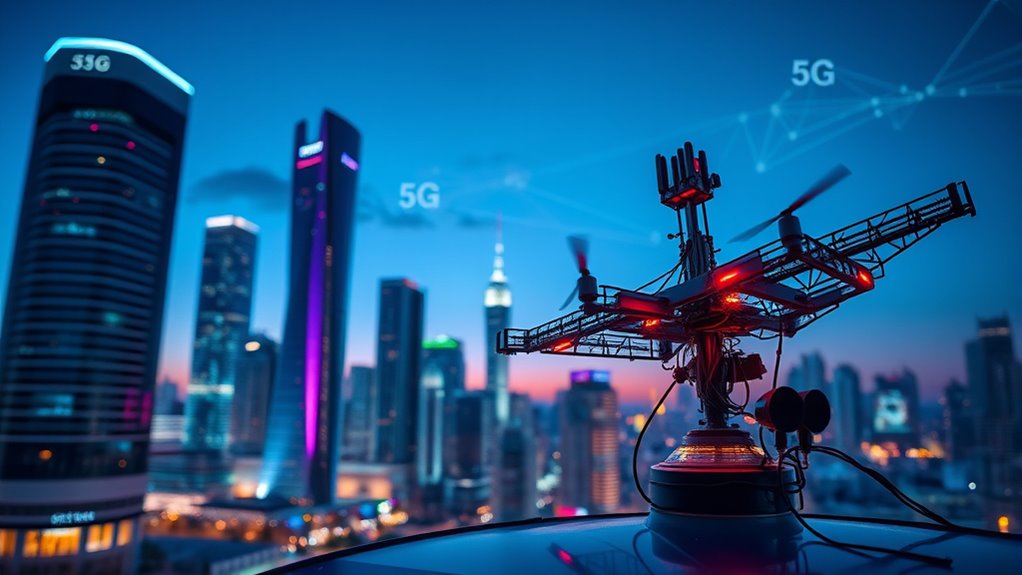As you explore 5G networks, you’ll find they offer faster speeds and better connectivity, opening new opportunities. However, these networks also pose risks, especially for espionage, due to the massive data they transmit and the many vulnerable connected devices. Cybercriminals and hostile entities could exploit weaknesses, leading to data theft or surveillance. To understand how to protect yourself and your organization from these emerging threats, consider what lies ahead in secured 5G development.
Key Takeaways
- 5G’s expanded data transmission increases opportunities for espionage through intercepting sensitive personal and corporate information.
- Complex 5G infrastructure and numerous connected devices create vulnerabilities exploitable for covert surveillance activities.
- Weak security in IoT devices used in 5G networks can serve as entry points for espionage and data breaches.
- Advanced AI and surveillance tools in 5G environments heighten risks of targeted monitoring by state or malicious actors.
- Ensuring robust security protocols and privacy protections is critical to mitigate espionage risks in 5G networks.

As 5G networks roll out worldwide, they promise to revolutionize how we connect, communicate, and access information. But with this rapid advancement comes significant concerns, especially regarding data privacy and cybersecurity threats. When you start using 5G-enabled devices and services, you might not immediately realize how much more vulnerable your personal information could become. 5G’s increased speed and connectivity mean more data is transmitted in real-time, creating new opportunities for malicious actors to intercept or exploit sensitive information. Cybercriminals are constantly evolving their tactics, and the expanded attack surface that 5G introduces makes it easier for them to target individuals, companies, and even governments.
Data privacy becomes a major concern as 5G networks handle vast amounts of data from IoT devices, smartphones, and enterprise systems. Every time you connect to a new device or service, your personal details, location, and habits could be collected and potentially shared without your knowledge. This raises questions about who has access to your data and how securely it’s stored. Without robust privacy protections, your information could fall into the wrong hands, leading to identity theft, financial loss, or even targeted surveillance. The faster and more interconnected the network, the more critical it becomes to safeguard your data from unauthorized access. Additionally, AI-driven cybersecurity solutions are increasingly being implemented to detect and prevent threats in this complex environment.
As 5G connects more devices, protecting your personal data from unauthorized access becomes increasingly vital.
Cybersecurity threats also escalate with 5G because the infrastructure is more complex and distributed than previous generations. Hackers can exploit vulnerabilities in network hardware, software, or poorly secured devices connected to the network. As 5G expands the number of connected endpoints, it increases the likelihood of breaches. You might find yourself exposed through compromised IoT devices, which are often less secure than traditional systems. These devices can serve as entry points for cyberattacks, allowing hackers to infiltrate networks more easily. The stakes are higher because a successful attack on a critical infrastructure or a major corporation could have widespread consequences, from financial disruptions to national security risks. Additionally, leveraging advanced projector technology can help in security and surveillance applications, highlighting the importance of safeguarding visual data.
While 5G offers exciting opportunities for innovation, it also demands heightened vigilance. Protecting your data privacy and defending against cybersecurity threats require continuous updates, strong encryption, and awareness of potential risks. As the technology evolves, so must your understanding of how to stay safe in this new digital landscape. Without careful management, the vulnerabilities of 5G could overshadow its benefits, making it essential for both individuals and organizations to prioritize security and privacy at every level.
Frequently Asked Questions
How Do 5G Networks Impact Individual Privacy Rights?
You might wonder how 5G networks impact your privacy rights. These networks can enhance data privacy by offering stronger encryption, but they also raise surveillance concerns. With faster data transfer, your personal information could be more vulnerable if security measures aren’t strict. You need to stay informed about how your data is collected and used, and demand transparency from providers to protect your privacy in this evolving digital landscape.
What Are Government Regulations Governing 5G Security Measures?
You need to understand that government regulations focus on regulatory compliance and security frameworks to protect 5G networks. They establish standards, enforce policies, and require organizations to implement robust security measures. These regulations aim to prevent unauthorized access, data breaches, and espionage. By adhering to these rules, you help guarantee the integrity of 5G infrastructure, safeguarding both national security and user privacy in an increasingly connected world.
Can Existing Cybersecurity Tools Effectively Protect 5G Infrastructure?
You can rely on existing cybersecurity tools to protect 5G infrastructure, but their effectiveness depends on implementing strong encryption protocols and network segmentation. Encryption keeps data secure during transmission, while segmentation limits access and isolates sensitive parts of the network. These measures help prevent unauthorized access and espionage. However, continuous updates and adaptations are vital, as 5G’s complexity requires advanced, proactive security strategies to stay ahead of evolving threats.
How Do 5G Vulnerabilities Compare to Previous Network Generations?
Imagine hackers exploiting 5G’s unique hardware vulnerabilities, like in a recent case where smart city sensors were compromised. Compared to previous networks, 5G’s increased reliance on network encryption offers better security, but its complex hardware introduces new vulnerabilities. You must understand that these hardware weaknesses could be exploited for espionage, making 5G more susceptible in some ways, despite advanced encryption measures. Staying vigilant is essential as technology evolves.
What Role Do International Alliances Play in 5G Security Standards?
You should understand that international collaboration and standard-setting alliances are essential for 5G security. These alliances, like the 3GPP and ITU, help establish common security standards, ensuring interoperability and reducing vulnerabilities. By working together, countries can share best practices, develop robust security protocols, and counteract potential espionage threats. Your awareness of these alliances highlights their critical role in creating a safer, more secure 5G infrastructure worldwide.
Conclusion
As you navigate the world of 5G, remember it’s like walking a tightrope between a dazzling technological wonder and a shadowy domain of espionage. While the opportunities promise a future glowing with innovation, the risks are dark clouds lurking on the horizon. Stay vigilant, for in this race for connectivity, your security is the anchor that keeps you steady amid the storm. Embrace the promise wisely, lest the shadows overtake the bright horizon ahead.








